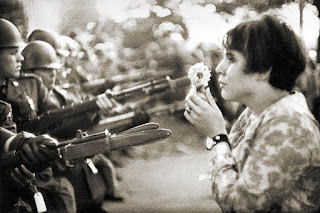 |
'Landing', 2013. Grateful acknowledgement to Sadradeen Ameen |
In its primary and abstract appearance, nothing is precisely 'that' 'which' it is not. However, the word is still there, in the words of all the languages we know. Here we explore its primary meaning in Hungarian.The Hungarian word for nothing – 'semmi' – is a compound of 'sem' (nor) and 'mi' (we). The negative 'sem' expresses: 'nor here' (sem itt), 'nor there' (sem ott), 'nor then' (sem akkor), 'nor me' (sem én), 'nor him, nor her' (sem ő). That is to say, I or we have searched everywhere, yet have found nothing, nowhere, never.
However much we think about it, the not of 'sem' is not the negating 'not', nor the depriving 'not' which Heidegger revealed in his analysis of 'das Nichts'. The not in the 'sem' is a searching not! It says, in fact, that searching we have not found. By this, it says that the way that we meet, face, and confront the not is actually a search. Thus the 'sem' places the negation in the mode of search, and the search into the mode of not (that is, negation).
What does all this mean in its essence?
Firstly, it means that, although the 'sem' is indeed a kind of search, which 'flows into' the not, still it always distinguishes itself from the nots it faces and encounters. For searching is not simply the repetition of a question, but a question carried around. Therefore the 'sem' is always about more than the tension between the question and its negative answer, for the negation itself – the not – is placed into the mode of search! And conversely.
Therefore the 'sem' never negates the searching itself – it only places and fixes it in its deficient modes. This way, the 'sem' emphasises, outlines, and suffuses the not, yet stimulates the search, until the exhaustion of its final emptiness. The contextually experienced not – that is, the 'sem' – is actually nothing but an endless deficiency of an emptied, exhausted, yet not suspended search.
This ensures on the one hand, the stability of the 'sem', which is inclined to hermetically close up within itself – while it ensures on the other hand, an inner impulse for the search which, emanating from it, continues to push it to its emptiness.
It is in the horizon of this impulse, then, that the 'sem' merges with the 'mi'. The 'mi' in Hungarian is at the same time an interrogative pronoun and a personal pronoun. Whether or not this linguistic identity is a 'coincidence', it conceals important speculative possibilities, for the 'mi' pronoun, with the 'sem' negative, always says that it is 'we' (mi) who questioningly search, but find 'nothing' (semmi).
Merged in their common space, the 'sem' and the 'mi' signify that the questioners – in the plurality of their searching questions – only arrived at, and ran into, the not, the negation. Therefore the Hungarian word for the nothing offers a deeper and more articulated consideration of what this word 'expresses', fixing not only the search and its deficient modes, but also the fact that it is always we who search and question, even if we cannot find ourselves in 'that' – in the nothing.
That is to say, the nothing – in this, which is one of its meanings – is precisely the strangeness, foreignness, and unusualness that belongs to our own self – and therefore all our attempts to eliminate it from our existence will always be superfluous.
Király V. István is an Associate Professor in the Hungarian Department of Philosophy of the Babes-Bolyai University, Cluj, Romania. This post is an extract selected by the Editors, and adjusted for Pi, from his bilingual Hungarian-English Philosophy of The Names of the Nothing.





